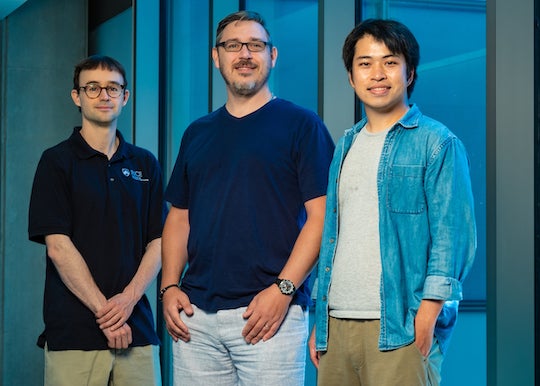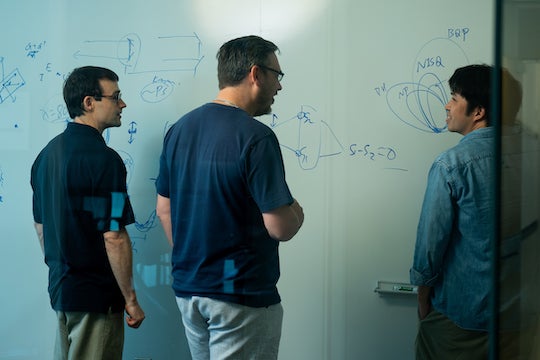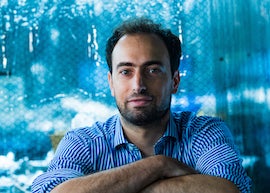A team of Rice University researchers have won a 4-year, $1.2 million grant from the Department of Energy (DOE) to evaluate the strengths and limitations of different physical systems used to build quantum computers.

Nai-Hui Chia, Kaden Hazzard and Kevin Slagle will use theory, numerical simulations and quantum hardware-run algorithms to provide a framework for comparing the viability and computational potential of different approaches to building quantum computers to help achieve near-term advances in quantum computing. Their project is one of six selected by the DOE "to improve our understanding of whether, when and how quantum computing might advance the frontiers of computational science," according to the agency.
"We haven't yet identified the best physical architecture to build a full-fledged quantum computer, but there are several different ways to get there," said Chia, an assistant professor of computer science. "This project aims to use mathematical models to figure out the different drawbacks or benefits involved with each option and to identify which architecture has the potential to lead to a near-term quantum advantage."
Hazzard, an associate professor of physics and astronomy, added that there may be more than a single answer to this question.
"Maybe some physical systems are better for some types of computing task than others," Hazzard said. "The question we're asking is for the types of algorithms we know quantum computers could be good at, are some architectures going to be better than others? Or how should you best embrace the capabilities of these different architectures?"
Interest in quantum computing has grown over the past decade due to advances in the experimental design of quantum systems that have made them more feasible.

or decades, quantum computing research was a backwater that had almost no funding and just a few people working on it on the fringes," said Hazzard. "Quantum systems are very fragile and difficult to control, but once advances hit a certain threshold 10-15 years ago, interest surged motivated by potential applications to simulation and sensing and understanding materials and chemical reactions."
Quantum computing could shed light on quantum-level phenomena like protein folding or catalytic reactions that remain beyond the computing capabilities of digital technology. From drug design to sustainability solutions, the possibilities of this new technological frontier have piqued the interest of a growing number of actors.
"A lot of funding has been going into quantum computing recently," said Slagle, an assistant professor of electrical and computer engineering. "There are many more startups now than there were five years ago, and this is just getting started."
Even though efforts to turn quantum computing from fledgling potential to robust capability have picked up momentum, it's still too early to tell what a quantum future might look like, Slagle added.
"We know quantum computers will likely be very useful for simulating quantum mechanics," he said. "But as was the case with classical computers in the beginning, it's difficult to say what the most important applications will be."

The researchers will collaborate with Guido Pagano, assistant professor of physics and astronomy at Rice, and Norbert Linke, adjunct assistant professor of physics at the University of Maryland, to test their evaluative framework on current quantum systems.
Pagano works with trapped atomic ions ⎯ one of the most popular candidates to perform quantum algorithms ⎯ and received a DOE Early Career Research Award to build a trapped-ion quantum system for the analog simulation of nuclear physics models.
"I look forward to the collaboration with this newly formed DOE team on quantum architectures," Pagano said.
The researchers will also provide opportunities to students to learn about and participate in quantum research.
"I want to remove barriers to entering the quantum computing field, because I think many computer science students, for instance, may shy away from quantum computing, thinking they need a strong physics background to understand it, but that's not necessarily the case," Chia said. "I want to create courses that build on students' strengths to allow them to engage with this subject."
Chia, Hazzard and Slagle were hired as part of the Quantum Initiative and their grant proposal was supported in part by the Smalley Curl Institute at Rice.
- Image downloads:
-
CAPTION: Kevin Slagle (from left), Kaden Hazzard and Nai-Hui Chia won a 4-year, $1.2 million grant from the Department of Energy for research on quantum computing. (Photo by Jeff Fitlow/Rice University)
CAPTION: Kevin Slagle (from left), Kaden Hazzard and Nai-Hui Chia. (Photo by Jeff Fitlow/Rice University)
CAPTION: Kevin Slagle (from left), Kaden Hazzard and Nai-Hui Chia aim to inform strategies for achieving near-term advances in quantum computing. (Photo by Jeff Fitlow/Rice University)
CAPTION: Guido Pagano is an assistant professor of physics and astronomy at Rice University. (Photo by Jeff Fitlow/Rice University)






